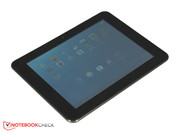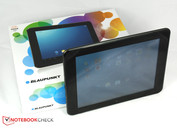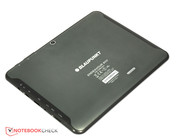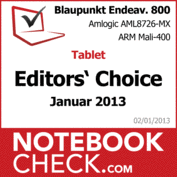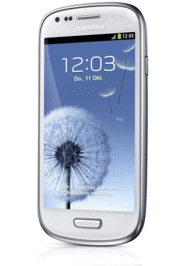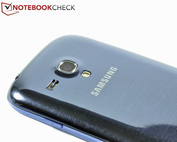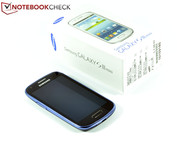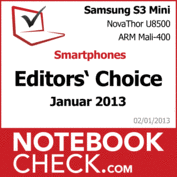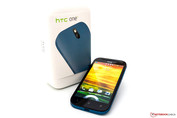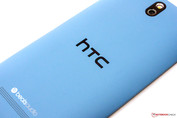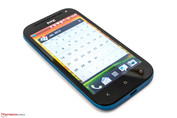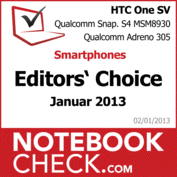Notebookcheck's Best of January 2013 – Smartphone and Tablet Edition
For the original German review, see here.
The manufacturers, in particular Google, swamped the market in the Christmas month of December. As known, people are in a more generous mood and retailers looks forward to a boost in sales figures. Things calmed down after the holidays and 2013 started off quite slow. Nevertheless, a total of five tablets came to our office. In contrast to the big names seen by us in recent months, rather unknown tablet brands showed up – with the exception of Acer. But the Iconia B1 perfectly fit January, which was dominated by affordable, partly cheap devices. In addition to Acer, Braun's B-Tab 711, Pearl's Touchlet X10.dual, cmx's Rapax 070-0508 and Blaupunkt's Endeavour 800 were among these. While the latter can still boast of a fairly well-known name, Braun and cmx play a significantly lesser role. Pearl is better known as a jack of all trades and thus now includes tablets.
We also noted five contenders in the smartphone sector. They all came from well-known brands and a few even from the big names in the cell phone industry. However, the objective in January was not to achieve new excellence but rather to strengthen the midrange. HTC supplied two devices. HTC's Windows Phone 8S poaches in Windows territory and HTC's One SV strolls through the fields of the Android competition. It had to compete against Samsung's Galaxy S3 Mini and Sony's Xperia J. Nokia's Lumia 820 designated HTC's Windows Phone 8S as a worthy opponent. This collection sets up doubtlessly gripping duels.
Samsung's Galaxy Camera played a special role. Though its heart is a compact camera with a wide zoom range, it provides all the features of a tablet and yet is no bigger than a smartphone. Somehow, the cam wanders between the worlds and therefore we do not include it in our lineup of contenders. Nevertheless, its good rating should not be left unmentioned.
Category: Tablets
Contenders:
Braun B-Tab 711: 74 %
Pearl Touchlet X10.dual: 83 %
Acer Iconia B1-A71: 82 %
cmx Rapax 070-0508: 74 %
Blaupunkt Endeavour 800: 84 %
Tablets had a bit of a rough start going into the New Year at notebookcheck.com. A real budget device faced our test range in the Braun's B-Tab 711. Some hurdles were simply too high to take. While the casing reaped in praise for its aluminum back and the stable impression, we missed the one or other feature in connectivity like Bluetooth or GPS. Its 4 GB of internal memory was tight but it could fortunately be expanded. The criticism became more solid after that. The camera is virtually useless and photos come out blurry very easily. The screen proved to be dark and only provided weak viewing angle stability. We ultimately lowered its rating so not to leave it in an undeserved good light.
Pearl is also known for low prices. Its newest tablet generation, the Pearl Touchlet X10.dual, features a dual-core processor and a graphics card with just as many computing cores. 230 Euros (~$308) for a 10-inch device sounds good and the device does its job accordingly well. However, the tablet could not score in connectivity and camera quality. In return, we liked the smooth use of the latest Android system and its relatively good gaming suitability. The screen was also acceptable though it could be a bit brighter. Its resolution is also not really up-to-date, but the viewing angles are good. We couldn't complain much about the performance considering it is an affordable 10-inch tablet. Despite that, the Touchlet keeps a safe distance from high-end models. It scored 83% in the end. The small battery and the occasional crash prevented an even better rating.
We could hardly wait for the next "low-cost" tablet, Acer's Iconia B1. It is to provide good workmanship, decent performance and long battery runtimes for a mere 119 Euros (~$159). We asked ourselves whether it really represents an affordable tablet or whether it is just another cheap device for this price. The answer: The B1 naturally has its shortcomings, but the value for money ratio is very good. Only a few manufacturers, such as Prestigio, can compete with that. Asus has announced a similar upcoming price-breaker dubbed Memo Pad though. Back to Acer's B1: The choice of materials and workmanship made a rather low-end impression, the connectivity was appropriate. Unlike other manufacturers, Acer does not cross out any important features. Android Jelly Bean, Bluetooth 4.0 and GPS are installed. On the other hand, we would not have missed the camera and the TN screen presented shortcomings in brightness and viewing angle stability. Acer's B1 is a full-fledged tablet due to its smooth operation and appealing performance. Although it is a bit restrained in terms of graphics, it is quite satisfactory as a surf and mail device. An appealing battery life adds to that.
cmx – the newcomer from Austria now has a handful of tablets in its range. We ordered a device that is within the same price range as Acer's Iconia B1 called cmx Rapax 070-0508. However, the tablet by cmx is a real letdown in many areas and blows the same tune as Braun's B-Tab 711. The build is at most functional and the choice of materials is bottom of the barrel. In return, the connectivity is fairly good although it lacks GPS and Bluetooth. External devices, such as a UMTS dongle, can be connected owing to the OTG feature. Its handling was quite acceptable even if sporadic crashes and foreign language menu items were annoying. It fortunately does not sport any cameras. However, its real shortcoming is the poor screen. We have not yet seen anything worse in our test lab to date. Brightness rates that do not even achieve three digits and its extreme viewing angle dependency disqualify the Rapax for serious use. The good battery runtimes cannot save it either. Like Braun's B-Tab, we had to lower the final score for cmx's Rapax.
A familiar name, Blaupunkt, finishes off the tablet reviews in January. However, the car radio giant is still more an outsider in the tablet sector. The Endeavour range from which our test device comes also stands for affordable devices. The manufacturer demands 190 Euros (~$254) for the Blaupunkt Endeavour 800. The buyer gets a dual-core CPU alongside outdated graphics with only one core for that. A common thread ran through the entire test. The 8-inch tablet does not stand out positively or – more importantly – negatively from the crowd. We did not have much reason for complaint in terms of use and the performance is middling. What more can you demand from a tablet of this price range? Conclusively, the Blaupunkt supplies a solid performance.
Tablet of January 2013: Blaupunkt Endeavour 800
In view of the rather weak competition, a good performance is enough for a place in the limelight. Consequently, Blaupunkt's Endeavour 800 is January's Tablet of the Month. If we had a value for money award, Acer's Iconia B1 would be the leader.
Shortcut
What we like
The plain casing's solid build and the equally solid overall performance.
What we'd like to see
A newer Android version would be nice.
What surprises us
How consistently average the tablet fares in the test.
The competition
Tablets from the same price range, such as Google's Nexus 7 or the less expensive Acer Iconia A1-B71.
Category: Smartphones
Contenders:
Samsung Galaxy S3 Mini GT-I8190: 87 %
HTC Windows Phone 8S: 85 %
Nokia Lumia 820: 86 %
Sony Xperia J: 86 %
HTC One SV: 87 %
Five devices from the smartphone category also faced our tests. All had one thing in common: They belong to the midrange devices of their manufacturer. Samsung's Galaxy S3 Mini GT-I8190 tries to fit into the big footprints of Samsung's Galaxy S3 flagship. Samsung likely wanted to use the same sounding name to boost sales. Does the small S3 bear the name rightfully? We believe it does because the phone is not really mini with a 4-inch screen and the S3 Mini convinced us in most parts of the test. We only reproached its imperfect reception, the mediocre performance and the rather short warranty period of 12 months. On the other hand, Samsung's S3 Mini reaped in more points on the pro side. It is fairly lightweight, features flawless workmanship and adequate connectivity and bids a relatively bright screen with crisp colors and absolute viewing angle stability. The rear-facing camera is even suitable for taking pictures and videos, which is not always the case in the smartphone sector. Its flawless handling and Android Jelly Bean complete the good total score.
HTC also supplies a midrange device with its Windows Phone 8S, which is to benefit from the splendor of HTC's 8X premium model. The latter managed to win our Best of November 2012 award. Like the name suggests, the manufacturer equips the 8S with Windows Phone 8. A good choice considering its use. The smartphone OS from Redmond has almost always received positive remarks from us until now. Unlike HTC's 8X, the "smaller" 8S comes with a microSD slot, which is also necessary in view of the tight internal memory. The user however has to accept drawbacks in resolution and the non-removable battery. There was barely any reason to reproach the screen's brightness, materials or the workmanship. Controls were mostly intuitive and smooth. However, the casing's spongy buttons marred the impression a bit. The four available colors provide a welcome change. Ultimately, a good result of 85% is recorded in the rating chart.
Nokia's Lumia 820 has almost the same starting position as HTC's 8S. The premium model Lumia 920 already exists and the Finnish manufacturer added the midrange early this year. Unlike Samsung's S3 Mini and HTC's 8S, the Lumia 820 achieved exactly the same rating as its bigger counterpart. This was particularly due to its flawless workmanship, very smooth controls and the above-average battery runtime. Even the screen convinced us to a large extent. Our records show sufficient brightness, vivid colors and a fantastic contrast. The midrange Windows phone also scored with an appealing performance that not always managed its way into the top ratings, but led to perfect and stutter-free control. And this is what counts in everyday use. However, its high weight and bulky shape might be a drawback.
Sony currently seems to believe ”more is better” in product development. This is virtually the only explanation why the Japanese manufacturer is throwing new Xperia models on the market on a weekly basis. One of the latest models is Sony's Xperia J, which is a conventional smartphone when looking at the key specs. An RRP of 240 Euros (~$321) is also a quite reasonable price. The slow clocked single-core processor, 512 MB of working memory and the low-performance graphics unit correspond to that. Nevertheless, the buyer gets a flawlessly manufactured phone including a 4-inch high-resolution screen in a midrange device. We did not have many points of complaint for the bright, high-contrast and stable viewing angle screen. But we did for camera quality and the device's performance. All pictures exhibited a visible bluish cast and the Xperia J's power was at most enough for the lower midfield. It is unusual for a modern phone not to be able to render HD videos. In return, the battery runtime proved to be first-rate.
The second HTC. With the One SV, HTC expands its successful Android smartphone family by a model featuring a fast LTE module, optimized hardware and a card reader. A look at the tech specs including a dual-core CPU and the price of 430 Euros (~$576) make it evident that HTC's One SV is still within the midrange, but with aspirations for the upper range. The 1 GB of memory and the decent graphics correspond to that. However, the SV's mediocre resolution positions it as a midrange device. Nevertheless, the positive aspects clearly outweigh the negative ones. They start with the decent build quality and the pleasant subjective feel, followed by the good speech quality and high-end screen and do not finish even with the removable battery and the appealing performance. Criticism? There is hardly anything to mention. Android Ice Cream Sandwich was not the newest, the included headset made a cheap impression and the speaker was at most middling. However, we found HTC's One SV compelling overall.
Smartphones of January 2013: Samsung Galaxy S3 Mini GT-I8190 and HTC One SV
Again, the room for the smartphones on the winner's podium is tight. All reviewed devices are only two percent points apart and all are consequently good. Nevertheless, Samsung's Galaxy S3 Mini GT-I8190 and HTC's One SV stand out by a hair's breadth and win our award.
Shortcut Samsung Galaxy S3 Mini
What we like
Appealing performance in a compact, elegant casing and the microSD card reader.
What we'd like to see
A stronger processor could have been installed and the camera modules could have used a few more MPs.
What surprises us
That it is noticeably thicker than Samsung's Galaxy S3 and the abysmal front-facing camera.
The competition
Current midrange smartphones featuring Android 4.x. Serious contenders are, for example, Google's Nexus 4 and HTC's One S.
Shortcut HTC One SV
What we like
The attractive looks, the open design in terms of battery and card reader, the connectivity features and good speech quality.
What we'd like to see
Primarily a higher resolution screen. Besides the established HD standards (720p & 1080p), we would have appreciated a qHD screen with 960x540 pixels (16:9).
What surprises us
The offered concept. A coherent overall package for a midrange smartphone although the screen's low resolution spoils the fun.
The competition
Google's Android: Google Nexus 4 from 300 Euros (~$402), Motorola's RAZR i featuring Intel SoC, the tried HTC One S in an aluminum casing or Sony's Xperia T. Apple's iPhone 5 is a frequently mentioned reference although it plays in another league. Microsoft Windows Phone 8: HTC's Windows Phone 8S or Nokia's Lumia 820.


